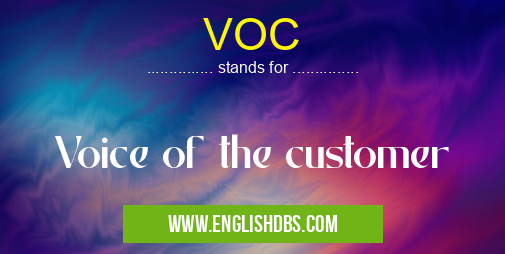What does VOC mean in TECHNOLOGY
Voice of the Customer (VOC) is a fundamental concept in customer-centric businesses that emphasizes capturing and understanding the perspectives, needs, and desires of customers. It involves gathering and analyzing customer feedback to gain insights into their experiences, preferences, and expectations. By effectively listening to the VOC, organizations can tailor their products, services, and processes to meet customer demands and drive business growth.

VOC meaning in Technology in Computing
VOC mostly used in an acronym Technology in Category Computing that means Voice of the customer
Shorthand: VOC,
Full Form: Voice of the customer
For more information of "Voice of the customer", see the section below.
» Computing » Technology
Meaning in COMPUTING
In the context of computing, VOC often refers to the process of collecting and analyzing customer feedback through various channels, such as surveys, interviews, social media platforms, and online reviews. By leveraging big data analytics and machine learning techniques, organizations can extract actionable insights from customer data to improve user experience, enhance product functionality, and resolve customer pain points.
Full Form
Voice of the Customer (VOC)
What does VOC Stand for?
Voice Of the Customer
Essential Questions and Answers on Voice of the customer in "COMPUTING»TECHNOLOGY"
What is Voice of the Customer (VOC)?
Voice of the Customer (VOC) refers to the process of gathering, analyzing, and interpreting customer feedback to understand their needs, expectations, and overall experiences with a product, service, or brand. The primary goal of VOC is to improve customer satisfaction, loyalty, and ultimately drive business growth.
Why is VOC important?
VOC is crucial for businesses because it provides valuable insights into the customer's perspective. By listening to their feedback, companies can identify areas for improvement, develop more effective strategies, and create products and services that better meet customer needs. Understanding the VOC also helps businesses address customer concerns proactively, preventing potential dissatisfaction and negative word-of-mouth.
What are the different ways to collect VOC? A: There are multiple methods to gather VOC, including: Customer surveys: Structured questionnaires designed to collect quantitative data on customer satisfaction, preferences, and experiences. Customer interviews: In-depth conversations with customers to gather qualitative feedback and uncover their underlying motivations, pain points, and aspirations. Focus groups: Moderated discussions with a small group of customers to generate insights on specific topics or product concepts. Social media monitoring: Analyzing customer interactions, feedback, and comments on social media platforms. Customer support dat
There are multiple methods to gather VOC, including:
- Customer surveys: Structured questionnaires designed to collect quantitative data on customer satisfaction, preferences, and experiences.
- Customer interviews: In-depth conversations with customers to gather qualitative feedback and uncover their underlying motivations, pain points, and aspirations.
- Focus groups: Moderated discussions with a small group of customers to generate insights on specific topics or product concepts.
- Social media monitoring: Analyzing customer interactions, feedback, and comments on social media platforms.
- Customer support data: Collecting and analyzing customer interactions with support channels, such as phone calls, emails, and live chat, to identify common issues and areas for improvement.
How can businesses analyze and interpret VOC?
To analyze VOC effectively, businesses can employ various techniques, including:
- Text analysis: Using software to analyze customer feedback data, identify common themes, and extract key insights.
- Sentiment analysis: Determining the emotional tone of customer feedback to gauge customer satisfaction and identify areas of concern.
- Root cause analysis: Investigating the underlying reasons behind customer dissatisfaction or negative experiences to identify potential solutions.
- Data visualization: Creating charts, graphs, and dashboards to visualize VOC data and make it easier to understand and interpret.
How can businesses use VOC to improve their products and services?
VOC can be leveraged by businesses to drive product and service improvements in several ways:
- Identifying pain points: VOC helps businesses identify areas where customers are experiencing challenges or dissatisfaction, allowing them to prioritize improvements that will address these issues.
- Developing new features: VOC provides insights into customer needs and expectations, enabling businesses to develop new features and enhancements that better meet those requirements.
- Improving customer experience: VOC feedback can be used to optimize customer touchpoints, streamline processes, and create a more seamless and positive overall experience.
- Personalizing interactions: Understanding the VOC helps businesses tailor their interactions with customers, providing personalized experiences that enhance satisfaction and loyalty.
Final Words: VOC is a crucial component of customer relationship management (CRM) strategies. By actively listening to and understanding the VOC, businesses can demonstrate empathy, build stronger relationships with customers, and ultimately increase customer satisfaction and loyalty. Moreover, VOC enables organizations to make data-driven decisions that align with customer needs, leading to improved product development, enhanced service offerings, and increased profitability.
